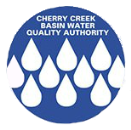2018 Annual Report on Activities
Cherry Creek Basin Water Quality Authority
Key Takeaways 2018
Monitoring and Compliance
Precipitation in the Cherry Creek watershed above Cherry Creek Reservoir was much lower than average during the 2018 Water Year, or about 61% of the recent 12-year average precipitation. It is noteworthy that the Cherry Creek’s headwater flows were 53% lower than average but flows were only 8% lower than average at the U.S.G.S. Parker gage on Cherry Creek.
Flow-weighted nutrient concentrations for all combined inflows to Cherry Creek Reservoir (including Cherry Creek, Cottonwood Creek, alluvial groundwater, and precipitation) were 206 μg/L (total phosphorus) and 1,691 μg/L (total nitrogen). In WY 2018, 10,144 pounds of total phosphorus and 82,518 pounds of total nitrogen were added to the reservoir and 4,622 pounds of total phosphorus and 35,373 pounds of total nitrogen were released from the reservoir.
In WY 2018, the July through September average chlorophyll α concentration in Cherry Creek Reservoir was 20.2 μg/L, which exceeded the 18 μg/L seasonal standard.
The Authority
The Authority is directed by an 18-member Board. Colorado Revised Statutes 25-8.5-100 et seq. provides several funding opportunities to the Authority. 2019 projected revenues are $2.8 million, of which at least 60% must be spent on the construction and maintenance of Pollution Abatement Projects.
Pollutant Reduction Facilities (PRFs)
In 2018, the Authority contributed over $960,000 towards restoration of almost 4,100 lineal feet of streams in the basin. One PRF, the Cottonwood Creek Perimeter Pond achieved 40% reductions in phosphorus, 19% reductions in nitrogen, and 51% reductions in total suspended solids during 2018 base flow conditions. $7.3 million of Pollution Abatement Project development, operations and maintenance included in the Authority 10 year Capital Improvement Plan.
Point Source Controls
In WY 2018, all 6 wastewater plants in the basin were in compliance with their nutrient discharge limits of 0.05 mg/L for total phosphorus – well below the 0.200 mg/L flow-weighted phosphorus concentration goal established for flow into the reservoir.
The Authority reviewed 3 site applications this year, resulting in the addition of required emergency overflow storage and/or differential flow metering at three lift stations.
MS4s
In 2018, over 15,000 inspections and over 1,800 enforcement activities were completed by our Municipal Separate Storm Sewer Systems (MS4s).
Modeling
The Authority’s HSPF (Hydrological Simulation Program-FORTRAN) Watershed Model was completed in 2018.
In 2018, the Authority approved the development of a Bubble Plume Model to occur concurrently with a Destratification System Study, and an update to the Reservoir Model to incorporate 2014-2017 data.
History
A new section has been added to the Annual Report this year, featuring the history of the watershed.
References
Another new feature this year is the References tab, which provides a ready-link to multiple related documents, from the Authority’s Statute, to the original 1984 Clean Lakes Study for Cherry Creek Reservoir, to Denver Public Library historic photographs of flooding on Cherry Creek.
